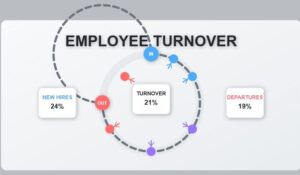Additionally, these surveys topics offer a unique glimpse into the hearts and minds of employees, providing insights that drive positive change.
1. Employee Attitude Objective (Survey Topics)
Understanding employees’ perceptions of the organization is vital for fostering a positive workplace culture. The Attitude Objective Survey Topic is a window into how employees perceive their organization. By gauging attitudes, sentiments, and opinions, employers gain a deeper understanding of what motivates and concerns their workforce. This employee survey allows organizations to fine-tune their strategies and address pain points. Additionally, it also helps gauge sentiments and reinforce employee satisfaction.
Importance: By capturing employees’ attitudes, organizations can address concerns promptly, boost morale, and cultivate an environment where employees feel heard and valued.
2. Psychometric Survey
The Psychometric Survey is a powerful tool that delves into the psychological dimensions of your workforce. Such employee survey topics employ scientifically validated assessments for insights into employees’ traits and work preferences. Furthermore, by utilizing sophisticated psychometric analysis, organizations can make informed decisions about team composition, leadership development, and talent management. As a result, such survey topics empower organizations to optimize employee-job fit, enhance team dynamics, and boost overall performance. With its data-driven approach, the Employee Psychometric Survey equips organizations with valuable insights for strategic HR planning. Ultimately, it leads to a more engaged, motivated, and harmonious workforce.
Importance: Identifying positive leadership traits empowers organizations to nurture and develop effective leaders, resulting in improved employee motivation and performance.
3. HR Department Ranking (Employee Survey Topics)
The HR Department Ranking Survey is a valuable tool that gauges employee perceptions and satisfaction regarding HR services. Such employee survey topics allow employees to provide feedback on various HR functions, from onboarding to benefits administration. In addition, by collecting insights on overall experience, organizations can identify strengths and areas for improvement within their HR department. These survey topics consequently fosters a sense of transparency and accountability, showcasing the organization’s commitment to enhancing HR services. Through data-driven analysis, the HRD Survey refines HR processes, elevates employee experiences, and creates a more efficient and employee-centric workplace.
Importance: Gathering HR-related ranking enhances employee experiences, drives process improvements, and builds a more transparent and responsive HR function.
4. Mental Wellness Survey
The Employee Mental Wellness Survey is a crucial tool that places employees’ well-being at the forefront. Such employee survey topics assess and address mental health concerns, offering a comprehensive understanding of employees’ emotional states. Moreover, by gathering valuable insights, organizations can tailor support programs and initiatives, fostering a positive workplace culture. These survey topics additionally empower employees to share their experiences confidentially, promoting open dialogue and reducing stigma around mental health. And finally, by prioritizing mental wellness, organizations enhance employee satisfaction, productivity, and overall organizational resilience. The Employee Mental Wellness Survey stands as a proactive step towards creating a supportive, thriving, and mentally healthy work environment.
Importance: Fostering a stress-free environment enhances employee well-being, reduces burnout, and contributes to higher productivity and engagement.
5. Goal Alignment (Survey Topics)
The Employee Goal Alignment Survey is a strategic tool designed to harmonize individual aspirations with organizational objectives. Through targeted inquiries and systematic analysis, this survey highlights areas of synergy and identifies potential misalignments. Additionally, by facilitating transparent communication and data-driven decision-making, it enhances strategic planning, resource allocation, and performance management. This survey also empowers employees know how their contributions contribute to overarching goals, fostering a sense of purpose and engagement. Furthermore, it cultivates a cohesive work environment, where every effort propels the organization forward. Leverage the insights from the Employee Goal Alignment Survey to optimize goal-setting, enhance collaboration, and drive sustainable success.
Importance: Consequently, when employees understand how their contributions contribute to larger goals, they’re motivated, engaged, and empowered to perform their best.
6. Employee Career Progression Survey
The Employee Career Progression Survey is a vital tool designed to illuminate the path toward professional growth within your organization. Through insightful inquiries, this survey offers deep understanding of employees’ career aspirations, skill development needs, and perceptions of advancement opportunities. Furthermore, by gathering valuable input, HRMs can tailor career plans, align individual goals with strategic objectives, and enhance employee satisfaction. This survey also fosters a proactive approach to nurturing talent, and ultimately contributing to a dynamic and thriving workforce. Elevate your organization’s success and employee achievements by harnessing the insights provided by the Employee Career Progression Survey.
Importance: Supporting career progression boosts employee satisfaction, retention, and performance, as they see a clear path for growth within the company.
7. Employee Happiness Survey
The Employee Happiness Survey is a vital tool that measures and evaluates the overall well-being and contentment of your workforce. Such employee survey topics provide a platform for employees to express their sentiments and feedback on various aspects. From job satisfaction to work-life balance, everything is covered. By gauging employee happiness, organizations can identify areas of success and areas that may require improvement. These survey topics also promotes a culture of open communication and demonstrates an organization’s commitment to employee well-being. The insights gained from the Employee Happiness Survey empower organizations to a great extent. It helps them make informed decisions that foster a positive and fulfilling work experience for all employees.
Importance: Happy employees are more productive, collaborative, and less likely to seek opportunities elsewhere.
8. Employee Daily Challenges Survey
The Employee Daily Challenges Survey is a strategic instrument designed to unveil the everyday obstacles faced by your workforce. Such employee survey topics offer a platform for employees to candidly express their daily challenges. This process helps organizations gain valuable insights into communication gaps, workload concerns, and collaboration hurdles. By pinpointing challenges, organizations can take targeted actions to enhance SOPs, streamline communication, and foster a more supportive work environment. The employee survey’s data-driven approach ultimately leads to improved job satisfaction and increased efficiency.
Importance: This practice holds significant importance, as overcoming these daily challenges not only boosts efficiency but also reduces frustration and contributes to fostering a positive work environment.
9. Know Each Department (Employee Survey Topics)
By facilitating cross-functional understanding, this employee survey gathers insights about how different departments function, thereby promoting improved collaboration.
Importance: This aspect holds particular importance as enhanced collaboration between departments within an organization fosters better communication, stronger teamwork, and ultimately, heightened overall organizational efficiency.
10. Assign Colors to HODs Survey
Assigning colors to different heads of departments (HODs) helps create a visual chart of leadership styles and their impact on the workforce.
Importance: This practice holds significance as it assists in visualizing leadership styles, thereby aiding in recognizing management strengths, aligning teams, and promoting effective leadership strategies.
Employee surveys are crucial in the workplace
Get the Advantages offered by HubEngage: The Feature-rich Enterprise Surveys Platform
Employee surveys provide a window into the hearts and minds of your workforce. In the dynamic realm, employee surveys have emerged as invaluable tools for organizational growth. Moreover, the most searched employee survey topics offer deep insights into employee sentiments, perceptions, and needs. Consequently, they empower organizations to tailor strategies, address concerns, and celebrate successes. Companies prioritizing employee engagement embark on a path to heightened staff satisfaction, improved morale, and collaborative goal attainment. Vital employee surveys shine a light on this trajectory, fostering a brighter and more fulfilling work environment. By fostering open communication and a sense of belonging, organizations cultivate a thriving culture where employees willingly contribute their best. This commitment to engagement fuels continuous improvement, elevating workplace dynamics and organizational outcomes.
The HubEngage Survey Module features over 30 ready-to-use employee survey topics and templates. You may use them as is or you may customize them to suit your specific needs. Click here to read more about the value proposition.













